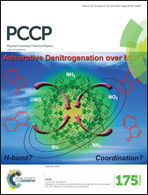Final rotational state distributions from NO(vi = 11) in collisions with Au(111): the magnitude of vibrational energy transfer depends on orientation in molecule–surface collisions†
Abstract
When NO molecules collide at a Au(111) surface, their interaction is controlled by several factors; especially important are the molecules' orientation with respect to the surface (N-first vs. O-first) and their distance of closest approach. In fact, the former may control the latter as N-first orientations are attractive and O-first orientations are repulsive. In this work, we employ electric fields to control the molecules' incidence orientation in combination with rotational rainbow scattering detection. Specifically, we report final rotational state distributions of oriented NO(vi = 11) molecules scattered from Au(111) for final vibrational states between vf = 4 and 11. For O-first collisions, the interaction potential is highly repulsive preventing the close approach and scattering results in high-J rainbows. By contrast, these rainbows are not seen for the more intimate collisions possible for attractive N-first orientations. In this way, we reveal the influence of orientation and the distance of closest approach on vibrational relaxation of NO(vi = 11) in collisions with a Au(111) surface. We also elucidate the influence of steering forces which cause the O-first oriented molecules to rotate to an N-first orientation during their approach to the surface. The experiments show that when NO collides at the surface with the N-atom first, on average more than half of the initial vibrational energy is lost; whereas O-first oriented collisions lose much less vibrational energy. These observations qualitatively confirm theoretical predictions of electronically non-adiabatic NO interactions at Au(111).


 Please wait while we load your content...
Please wait while we load your content...